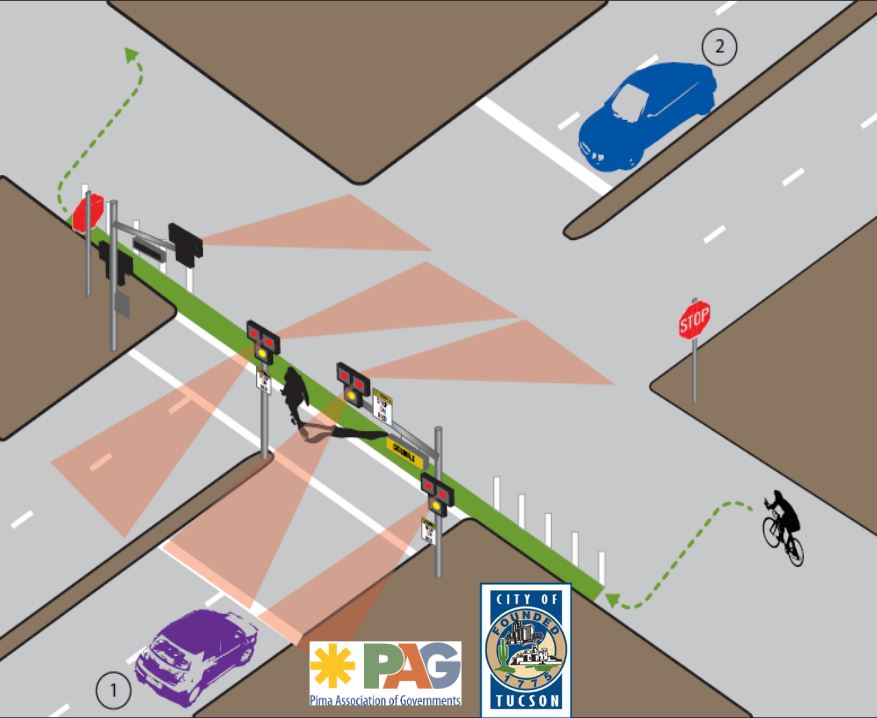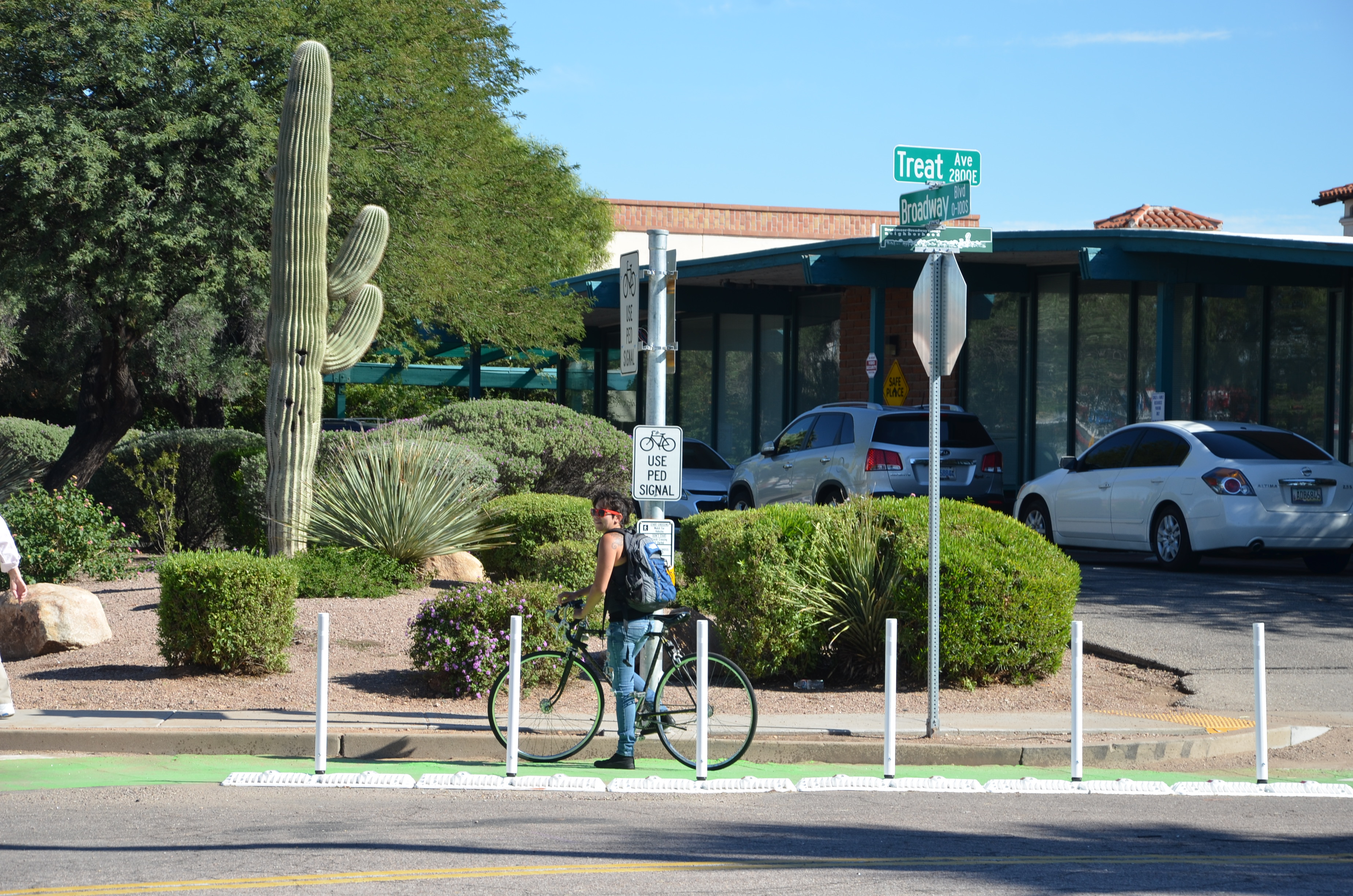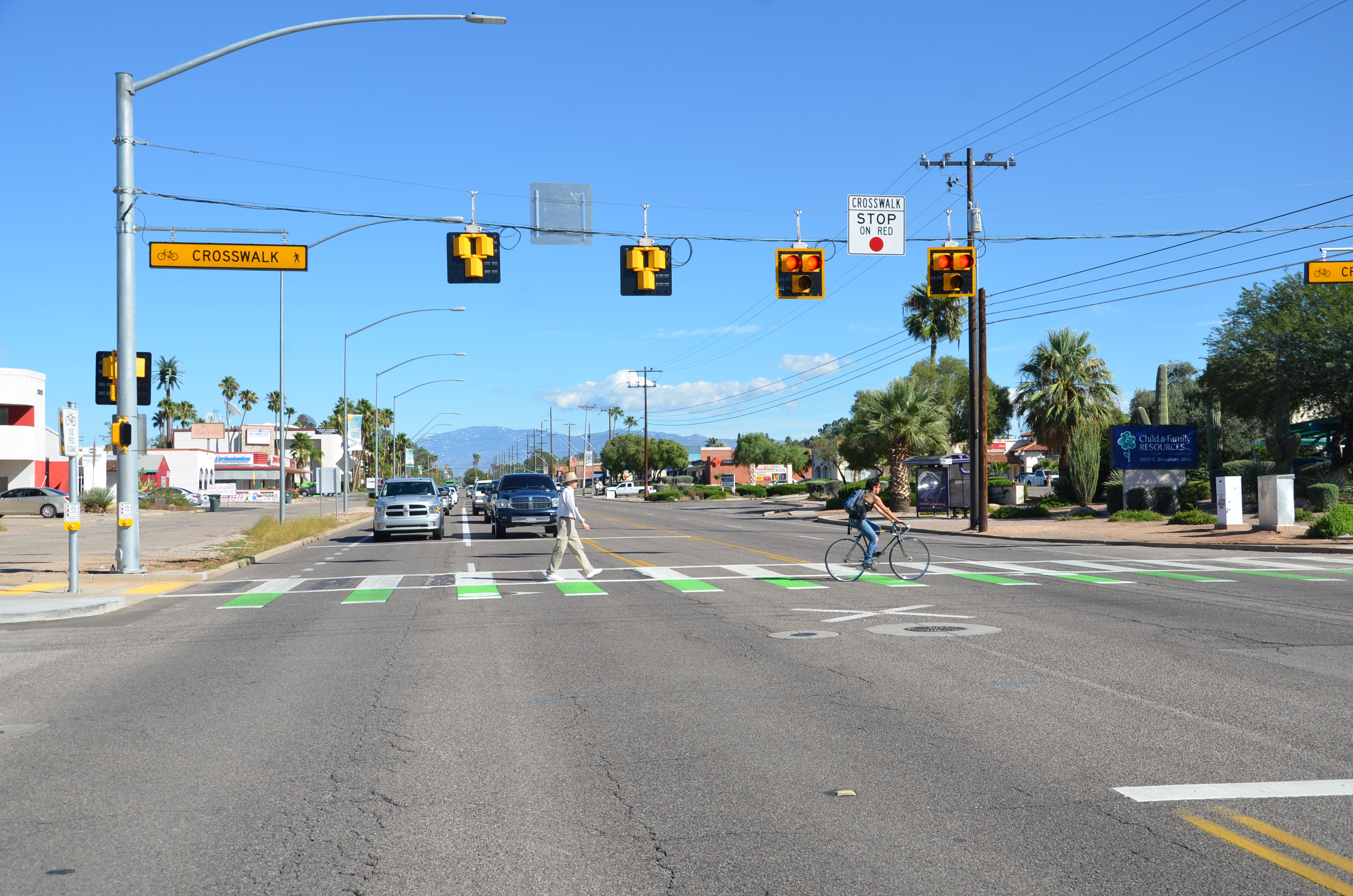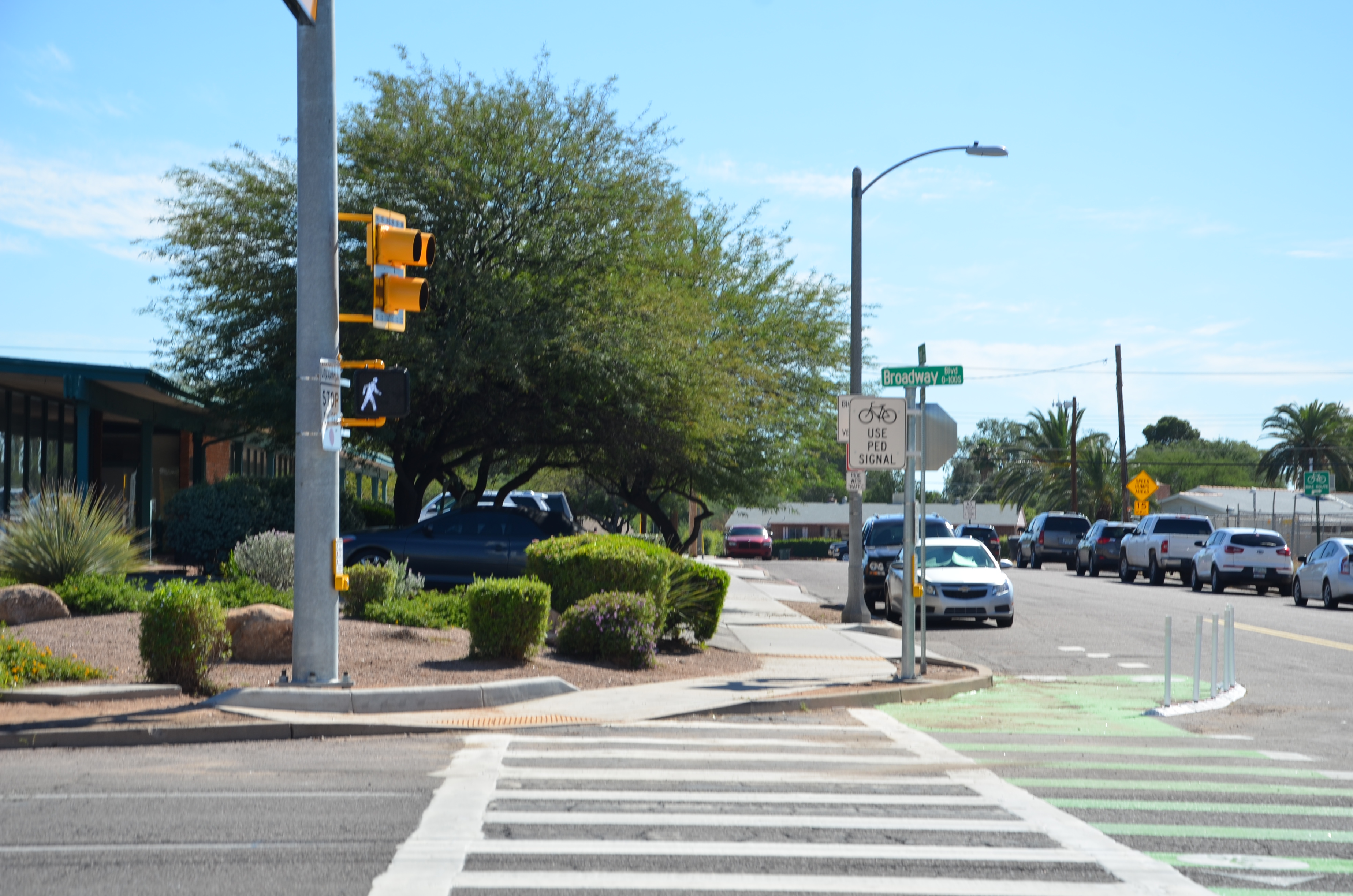BikeHAWK: Adapting the pedestrian hybrid beacon to aid bicyclists crossing busy streets
Tucson, Arizona
Source: Richard Nassi, Diahn Swartz, Ann Chanecka, Paul Casertano, and Gabe Thum
Problem
The City of Tucson's Bicycle Program changed its focus from simply providing bike lanes to identifying existing residential streets that can be enhanced to provide a network of low-stress bikeways. Having identified these bike boulevard routes, it is necessary address the safe and convenient crossing of the major arterial streets where they intersect these bike routes.
Many of these crossing locations already have a Pedestrian Hybrid Beacon (PHB) to assist pedestrians. The PHB crossings have a very high driver yielding rate and are an approved traffic control device (alternatively known as a HAWK) with its use and operation detailed in Chapter 4F of the Manual of Uniform Traffic Control Devices (MUTCD). Methods on how to achieve the same response and facilitate bicycle crossings was undertaken by the City of Tucson and the Pima Association of Governments (PAG).
Disclaimer: This case study documents Tucson, Arizona's experimentation with creating safe crossings for bicyclists at Pedestrian Hybrid Beacon locations. It is intended to highlight the experience of one agency and further the discussion and experimentation of similar measures. It is not intended as design guidance or best practice.
Background
Standard design of the BikeHAWK with the separated green lane next to the pedestrian crossing (current crossings use a green zebra stripe through the intersection to mark the conflict area and solid green in the landing areas of the separated lanes). The dotted lines show how a bicyclist traveling along the residential street is expected to enter and exit the green bike lane.
The City of Tucson collaborated with the Pima Association of Governments to expand the PHB crossing design to explicitly accommodate bicyclists, a design they named the BikeHAWK. The key to the BikeHAWK's success is that it was designed to match the observed natural behavior of bicyclists crossing at locations with PHBs. Tucson currently has five BikeHAWKs installed throughout the city and is set to double that number. The following section explains Tucson's experience with the BikeHAWK, which uses a combination of MUTCD approved signs, signals, and markings to guide bicyclists through the intersection of residential and arterial streets.
Solution
The PHB does not control a whole intersection, but rather controls only one crosswalk at an intersection. As a result, bicyclists using a PHB find that for one direction of travel they are on not on the same side of the road as the beacon. As indicated, the BikeHAWK design took a human factors approach, to observe bicyclists' behavior at a number of PHB locations and determine the way they naturally use the PHB crossing. The design was then developed by trying to match what the crossing bicyclists do to help ensure high compliance.
Each entrance to the BikeHAWK on the low volume residential street has a clearly marked, two-way separated bike lane painted solid green. Vertical separation is provided by a channelized curb and flexible delineator posts; however, there is no additional horizontal separation beyond the width of the curb. This design keeps motor vehicles away from the entrance to the BikeHAWK. The green separated bike lane legitimizes the observed, or normal, movement by the approaching bicyclist from the near center of the residential street toward the BikeHAWK crossing regardless of whether the bicyclists is on the left side or right side of the residential street. The green lane guides bicyclists to the proper position to activate the beacon at a curb-side pushbutton allowing the bicyclist to avoid having to dismount and use the pedestrian pushbutton on the sidewalk. The separated bike lane also narrows the width of the residential street at the major street intersection which provides the added benefit of traffic calming on the residential street.
Bicyclists ride up to the bike pushbutton next to the curb, calling for the red BikeHAWK crossing lights to be shown to the arterial street, note the standard size R9-5 BICYCLE (symbol) USE PEDESTRIAN SIGNAL sign above the button.
At the crossing itself, bicyclists see adjacent to the high-visibility crosswalk an eight-foot green path designated for their use. The bicyclist is directed to observe the pedestrian signal (MUTCD R9-5 sign: [BIKE SYMBOL] USE PEDESTRIAN SIGNAL).
Even though the majority of the bicyclists entered the crossing area at the PHB in a nearly identical fashion, the bicyclists left the crosswalk in three distinct patterns. Thus, the final design of the BikeHAWK encourages the better of the three exiting patterns. The same green separated bike lane that serves the entering bicyclists also is used by exiting bicyclists. As the bicyclist leaves the separated bike lane they normally gravitate back to the right of the center of the residential street. The two-way separated bike lane segment allows bicyclists to ride a short distance in the contraflow direction before crossing; this return movement is similar to a left turn into or out of a driveway on the side street and does not need any special warning. At the end of the contraflow lane, signs advise bicyclists that they are about to be riding in the wrong direction and that they need to ride with traffic. To provide further protection to the cycling traffic as they return to the residential street, drivers are not allowed to turn-right-on-red from the arterial onto the residential street.
BikeHAWK shows solid RED indications to the arterial traffic and a WALK indication with R9-5 signs for the bicyclist and pedestrian.
In summary, the key elements of the BikeHAWK include:
- A short separated green bike lane to position bicyclists into an area delineated by flexible posts;
- Placement of signal detection buttons in easy reach of bicyclists;
- Use of green pavement markings in a high-visibility crosswalk pattern adjacent to the high visibility white crosswalk;
- MUTCD approved signing advising cyclists to observe pedestrian signals (R9-5);
- MUTCD approved signs encouraging bicyclists to ride with traffic after the crossing has been completed and it is safe to make the maneuver (R5-1b and R9-3cP).
Because the design matches the bicyclist’s natural behavior and current traffic laws, along with the MUTCD, Tucson has found that little education has been necessary to achieve high compliance by all road users. However, Tucson has over 100 PHBs, so education will likely be necessary in communities that are seeing this type of beacon for the first time.
Evaluation and Results
The BikeHAWK has been well-received by the community. The news media interviewed bicyclists at the Third Street/Swan Road BikeHAWK, and all bicyclists indicated they understand and appreciate the new device. The most common theme in their response is that it makes them feel safer when crossing the busy street. Peak-period pedestrian and bicycle counts conducted at the BikeHAWK at Third Street/Swan Road by the Pima Association of Governments, during their normal counting program in 2012, have shown that:
- 96% of the riders use the BikeHAWK as designed;
- 100% of family riders with children or children alone use the BikeHAWK;
- 94% of the crossers were bicyclists and 6% were pedestrians;
- The device was easily understood by all users and bicyclists followed the designated paths with ease;
- There was a high level of driver compliance to the crossing device;
- 50% of riders using the BikeHAWK were males, 46% were females, and 6% were children. This level of female ridership is higher than the average regional and indicates a perception of safer facility.
Conclusions and Recommendations
The Tucson BikeHAWK employs traffic control devices and techniques that are already approved by the FHWA, MUTCD (note: the green pavement marking currently requires interim approval), and accepted by traffic engineers. The green two-way separated bike lane section further protects the bicyclists by identifying their area and the keeping of vehicles away. In addition, the flexible posts were observed to result in slower vehicular turning movements onto the residential street, creating an additional traffic calming effect for the residential street. The BikeHAWK not only serves the crossing bicyclists, but also the residential neighborhood.
Contacts
Richard B. Nassi, P.E., Ph.D.
Pima Association of Governments, Consulting Engineering Services
529.791.1093
Rnassi1@gmail.com
Diahn Swartz, P.E. PTOE
Traffic Engineering Manager
City of Tucson
520.791.4259
Diahn.Swartz@tucsonaz.gov
Ann Chanecka
Bicycle and Pedestrian Program Manager
City of Tucson
520.791.4371
Ann.Chanecka@tucsonaz.gov
Paul Casertano, AICP
Transportation Manager
Pima Association of Governments
520.792.1093
pcasertano@pagnet.org
Gabe Thum
Alternate Modes / Road Safety Assessment Project Engineer
Pima Association of Governments
520.792.1093
gthum@pagnet.org








